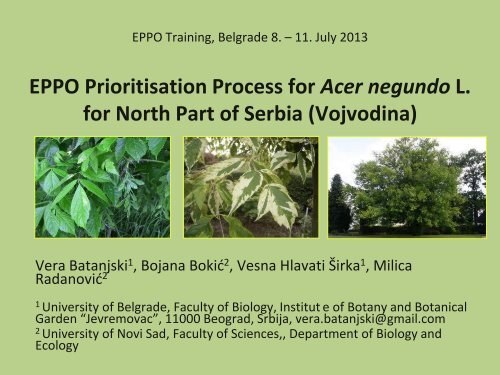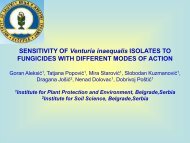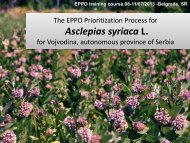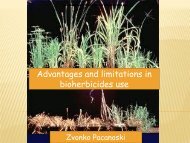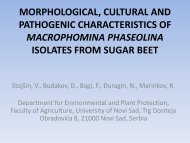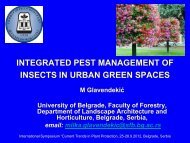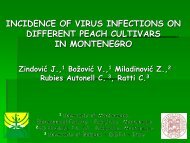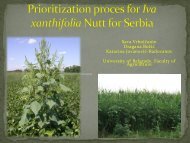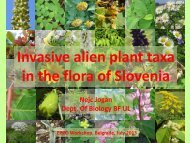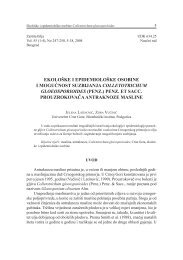Acer negundo L. Taxonomic position - Izbis
Acer negundo L. Taxonomic position - Izbis
Acer negundo L. Taxonomic position - Izbis
- No tags were found...
Create successful ePaper yourself
Turn your PDF publications into a flip-book with our unique Google optimized e-Paper software.
EPPO Training, Belgrade 8. – 11. July 2013<br />
EPPO Prioritisation Process for <strong>Acer</strong> <strong>negundo</strong> L.<br />
for North Part of Serbia (Vojvodina)<br />
Vera Batanjski 1 , Bojana Bokić 2 , Vesna Hlavati Širka 1 , Milica<br />
Radanović 2<br />
1<br />
University of Belgrade, Faculty of Biology, Institut e of Botany and Botanical<br />
Garden “Jevremovac”, 11000 Beograd, Srbija, vera.batanjski@gmail.com<br />
2<br />
University of Novi Sad, Faculty of Sciences,, Department of Biology and<br />
Ecology
<strong>Acer</strong> <strong>negundo</strong> L.<br />
<strong>Taxonomic</strong> <strong>position</strong>: <strong>Acer</strong>aceae<br />
Synonyms: Negundo aceroides Moench (1794), Negundo<br />
fraxinifolium (Nutt.) DC. (1824).<br />
Common names (EN): boxelder, maple ash
A.1 - Is the plant species known to be alien in all, or a significant<br />
part, of the area under assessment?<br />
• Yes<br />
<strong>Acer</strong> <strong>negundo</strong> is native to North America.
A.2 - Is the plant species established in at least a part of the area<br />
under assessment?<br />
• Yes<br />
The species has been observed in the area under<br />
assessment (protected areas, watershores along the<br />
rivers and banks, sand dunes, salt marshes etc.)<br />
Panjkovic et al. (2005), unpublished data.<br />
Introduced in Europe in XVII century as garden plant.
A.5 - How high is the spread potential of the plant in the area<br />
under assessment?<br />
• High<br />
Level of uncertainty: low<br />
Dispersed by wind or by birds and squirrels. Boxelder<br />
establishes by seed under a wide range of conditions<br />
(Udvardy, 2008).<br />
Given that box-elder seeds are able to survive in water for<br />
at least 6 weeks and to germinate before touching the<br />
ground (Mędrzycki, 2011 author's unpublished data),<br />
that mode of dispersal may be a long-distance one.<br />
Plant can produce approximately 30 000 seeds.
A.6 - How high is the potential negative impact of the plant on<br />
native species, habitats and ecosystems in the area under<br />
assessment?<br />
• High<br />
Level of uncertainty: low<br />
Specific impact is its permanent vegetative regrowth that<br />
leads to domination in the flood-plain forests.<br />
Dominates the lower tree canopy layer and almost totally<br />
stops regeneration of poplars and willows (Künstler<br />
1999).
A.7 - How high is the potential negative impact of the plant on<br />
agriculture, horticulture or forestry in the area under<br />
assessment?<br />
• Medium<br />
Level of uncertainty: low<br />
Appearing on different semi-natural habitats can be<br />
mentioned as its most important economic damage, as<br />
the main propagator of fall webworm (Hyphantria cunea<br />
Drury 1773) causing serious damages in horticultural<br />
crops (Udvardy, 2008).
A.8 - How high are the potential additional impacts (e.g. on<br />
animal and human health, on infrastructures, on recreational<br />
activities, other trade related impacts such as market losses)?<br />
• Medium<br />
Level of uncertainty: medium<br />
Positive impact: Riparian boxelder communities provide<br />
important habitat for many wildlife species and protect<br />
livestock from temperature extremes in summer and<br />
winter. Many species of birds and squirrels feed on the<br />
seeds of boxelder.<br />
Negative impact: This tree may be poisonous to livestock. It<br />
has an allelopathic effect because it produces<br />
terpenoids, triterpene saponins and alkaloids (Udvardy,<br />
2008).
Outcome of the first part:<br />
List of invasive alien plants
B.1 - Is the plant species internationally traded or are there other<br />
existing or potential international pathways?<br />
• Yes<br />
In the first half of the twentieth century it became one of the<br />
most commonly planted alien tree species (Medrzycki,<br />
2011 ) and it is still traded for ornamental purposes<br />
today.
B.2 - Is the risk of introduction by these international pathways<br />
identified to be superior to natural spread?<br />
No<br />
The risk of introduction by international pathways is lower<br />
than natural spreading in the observed area, because<br />
American boxelder is replacing white willow (Salix alba)<br />
riparian forests along southern European rivers<br />
(Bottollier-Curtet, M. et al., 2012)
Outcome of the second part:<br />
This plant is not a priority for PRA<br />
Recommendations for management at a national level<br />
through National Regulatory Control Systems (PM9) may<br />
be developed.
Conclusion<br />
• <strong>Acer</strong> <strong>negundo</strong> is on preliminary list of invasive alien<br />
species in Serbia (IASV http://iasv.dbe.pmf.uns.ac.rs/,<br />
Lazarević et al., 2012)<br />
• It degrades natural protected areas, and must be<br />
stopped.
References:<br />
• Botta-Dukát, Z. (2008): Invasion of alien species to hungarian (semi)natural habitats. Acta Botanica<br />
Hungarica 50(Suppl), pp. 219–227, 2008<br />
• Török, K., Botta-Dukát, Z., Dancza, I., Nemeth,, J., Kiss, B., Mihaly, & Magyar, D. (2003): Invasion<br />
gateways and corridors in the Carpathian Basin: biological invasions in Hungary. Biological Invasions 5:<br />
349–356, 2003.<br />
• IASV http://iasv.dbe.pmf.uns.ac.rs/<br />
• Vrbničanin, S., Lazarević, B. & Dajić-Stevanović, Z. (2004): Adventivne i invazivne korovske vrste na<br />
području Srbije. Acta Herbologica, 13 (1): 1-12.<br />
• Lazarević, P., Stojanović, V., Jelić, I., Perić, R., Krsteski, B., Ajtić, R., Sekulić, N., Branković, S., Sekulić,<br />
G. & Bjedov, V. (2012): Preliminarni spisak invazivnih vrsta u Republici Srbiji sa sa opštim merama<br />
kontrole i suzbijanja kao potpora budućim zakonskim aktima. Zaštita prirode, 62(1): str. 5-31.<br />
• Batanjski, V., Kabaš,, E., Kuzmanović, N., Vukojičić, S., Lakušić, D. & Jovanović, S. (2013): Florističke i<br />
fitocenološke karakteristike šuma sa dominacijom invazivnoh vrsta <strong>Acer</strong> <strong>negundo</strong> L. i Fraxinus<br />
pennsylvanica Marshall u Ramsarskom području “Carska bara” (Vojvodina, Srbija). 11 Simposium o flori<br />
jugoistocne Evrope i susednih regiona, Niš.<br />
• Nikolić, T. (2009): Flora Hrvatske, alohtona flora.<br />
• Boršić, I., Milović, M., Dujmovič, I., Bogdanović, S., Cigić, P., Rešetnik,, I., Nikolić, T. & Mitić, B. (2008):<br />
Preliminary chek-list of invasive alien plant species (IAS) in Croatia. NAT. CROAT, 17(2): 55-71 Zagreb.<br />
• Mędrzycki, P. (2011): NOBANIS – Invasive Alien Species Fact Sheet – <strong>Acer</strong> <strong>negundo</strong>. – From: Online<br />
Database of the European Network on Invasive Alien Species – NOBANISwww.nobanis.org, Date of<br />
access x/x/201x.<br />
• Panjković, B. Sabadoš, K. & Stojšić, V. (2005): Invazivne biljne vrste u zašitećenim prirodnim dobrima u<br />
Vojvodini. 8 Simpozijum o flori jugoistočne Evrope i susednim područjima, niš 2005
• Robert, M. & Ohmann, L. (1973): Boxelder (<strong>Acer</strong> <strong>negundo</strong>): A Review and Commentary. Bulletin<br />
of the Torrey Botanical Club, 100(6): 357-363.<br />
• Künstler P. 1999. The role of <strong>Acer</strong> <strong>negundo</strong> L. in the structure of floodplain forests in the middle<br />
course of the Vistula river. Proceedings of the 5th International Conference on the Ecology of the<br />
Invasive Alien Plants 13–16 October 1999. La Maddalena, Sardinia, Italy.<br />
• Porté, A., Lamarque, L., Lorte, C., Michalet, R. & Delzon, S. (2011): Invasive <strong>Acer</strong> <strong>negundo</strong><br />
outperforms native species in non-limiting resource environments due to its higher phenotypic<br />
plasticity. BMC Ecology 11.<br />
• Esch R.E., Hartsell C.J., Crenshaw R. and Jacobson R.S. 2001. Common Allergenic Pollens,<br />
Fungi, Animals, and Arthropods. Clinical Reviews in Allergy and Immunology 21: 261-292.<br />
• Von Schwerin F. 1919. Zur Ehrenrettung des <strong>Acer</strong> <strong>negundo</strong>. Mittilungen der Deutschen<br />
Dendrologischen Gesellschaft 28: 146–150.<br />
• Hegi G. 1977. Illustrierte Flora von Mitteleuropa Band V, Teil 1. Verlag Paul Parey. Berlin,<br />
Hamburg.<br />
• Udvardi, L. (2008): Boxelder (<strong>Acer</strong> <strong>negundo</strong>). In The most important invasive plants in Hungary<br />
(Eds. Botta-Dukát, Z. & Balogh, L.). Institute of Ecology and Botany, Hungarian Academy of<br />
Sciences, Vácrátót, Hungary pp. 115–120<br />
• Hernea,, C., Sabina, P. (2009): Studii si comunicari. Stiintele Naturii. Muzeul Olteniei Craiova.<br />
Tom. XXV, Oltenia.<br />
• Bottollier-Curtet, M., Charcosset, J.-Y., Poly, F., Planty-Tabacchi, A.-M. & Tabacchi, E.<br />
(2012):Light interception principally drives the understory response to boxelder invasion in riparian<br />
forests. Biol Invasions (2012) 14:1445–1458


